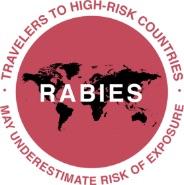Preventing Rabies
There are two situations where rabies vaccination is used:2
Preventing Rabies
There are two situations where rabies vaccination is used:2
- Pre-exposure prophylaxis (PrEP) - Vaccination before potential exposure to the virus
- PrEP won't eliminate the need for treatment after an exposure, but it can offer a level of protection, particularly against unrecognized exposures, and reduce the number of shots needed after an exposure.3
Learn about recommended PrEP dosing schedules
- Post-exposure prophylaxis (PEP) - Vaccination after exposure to the virus to stop the onset of rabies1,2
- Involves injection of rabies vaccine and human rabies immune globulin (HRIG)
- If PrEP was administered, only vaccine is required, but not HRIG
Learn about recommended PEP dosing schedules
Pre-exposure prophylaxis (PrEP)
Who should be vaccinated?
The CDC advises that people should consider pre-exposure vaccination if they are in frequent contact with the rabies virus or rabid animals, such as on the job, or if they're active outdoors and could encounter animals with rabies in the wild.5
Pre-exposure rabies vaccination also makes sense for travelers likely to come in contact with animals in parts of the world where rabies is common and immediate access to appropriate care is limited.6 People are encouraged to talk to their doctor or seek a pre-travel medical consult about their risk and if pre-exposure rabies vaccination is right for them.
PrEP is appropriate for persons in high-risk groups, including international travelers visiting areas where rabies is enzootic and immediate access to appropriate medical care, including biologics, may be limited.1
Why recommend PrEP?
Although PrEP does not eliminate the need for medical care following possible rabies exposure, PrEP:7,8
- Offers a level of protection, particularly to unrecognized exposures, through the presence of rabies antibodies in the weeks following vaccination
- Primes the immune response so that treatment after exposure (PEP), can be effective more quickly9
- Simplifies treatment:
- Eliminates the need for human rabies immune globulin (HRIG), which may not be readily available and
- Decreases the number of vaccine doses needed after suspected exposure7-9
- May also provide partial immunity for individuals whose PEP may be delayed7,8 or who are at continual, frequent or increased risk of unapparent or unrecognized exposure to the rabies virus due to their location or occupation8,9
What is human rabies immune globulin (HRIG)?
Read more- HRIG is a medication administered to previously unvaccinated persons to provide immediate access to neutralizing antibodies until the patient's immune system can respond to the vaccine and actively produce antibodies of its own10
- HRIG is administered only once, preferably at the initiation of PEP or within 7 days after the first dose of rabies vaccine10
- HRIG is infiltrated into and around any detectable wounds or administered intramuscularly when a bite site is unknown or indeterminate10
- Because HRIG can be difficult to obtain in some countries, access to appropriate care may be delayed. This, along with the level of exposure risk in a travel location, should be considered when recommending whether pre-exposure vaccination is appropriate10

Wound Management
Animal Bite

Clean the Wound

Consult an HCP
- If a wound is present, immediately wash it for at least 15 minutes using soap and water.2,14
- Wound washing helps to reduce rabies virus infection by eliminating or inactivating rabies virus particles that may have infiltrated the wound2,14
-
RabAvert® Prescribing Information. Available at: https://dailymed.nlm.nih.gov/dailymed/fda/fdaDrugXsl.cfm?setid=84b7a672-eeb1-4527-84ac-68196b156be2&type=display, Accessed October 2021.
-
World Health Organization (WHO). Rabies fact sheet. 27 September 2019.https://www.who.int/news-room/fact-sheets/detail/rabies, (accessed October 2021).
-
Centers for Disease Control and Prevention (CDC). Vaccine Information Statement. Rabies VIS. https://www.cdc.gov/vaccines/hcp/vis/vis-statements/rabies.html, (accessed June 2021).
-
North American Rabies Management Plan: A Partnership for Effective Management, 2008. US National Overview. https://www.aphis.usda.gov/wildlife_damage/oral_rabies/downloads/Final%20NARMP%209-30-2008%20(ENGLISH).pdf (accessed June 2021).
-
Centers for Disease Control and Prevention. Preexposure vaccinations. https://www.cdc.gov/rabies/specific_groups/travelers/pre-exposure_vaccinations.html
-
Centers for Disease Control and Prevention. Rabies. https://wwwnc.cdc.gov/travel/diseases/rabies
-
Manning SE, et al. MMWR Recomm Rep 2008;57(RR-3):1–28. https://www.cdc.gov/mmwr/preview/mmwrhtml/rr5703a1.htm
-
Center for Disease Control. Yellow Book. Chapter 4. 2018. https://wwwnc.cdc.gov/travel/yellowbook/2018/infectious-diseases-related-to-travel/rabies, (accessed June 2021).
-
World Health Organization (WHO). Wkly Epidemiol Rec 2018;93:201–20
-
Briggs DJ, et al. 2011. http://whqlibdoc.who.int/publications/2011/9789241501088_eng.pdf (accessed June 2021).
-
McIntosh I. Pre-Travel Health Consultation. Journal of Travel Medicine. 2015; 22.3;143-144.https://academic.oup.com/jtm/article/22/3/143/2563172
-
World Health Organization (WHO). Expert Consultation on Rabies. Second Report. 2013. http://apps.who.int/iris/bitstream/10665/85346/1/9789240690943_eng.pdf?ua=1, (accessed June 2021).
-
International Assistance for Medical Assistance to travelers. https://www.iamat.org/blog/5-misconceptions-about-rabies/, (accessed June 2021).
-
Rupprecht CE, et al. Plotkin’s Vaccines, Chapter 50, 7th edition. 2018.